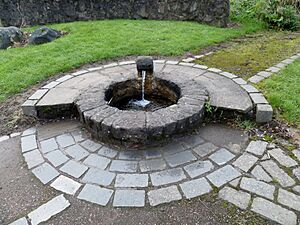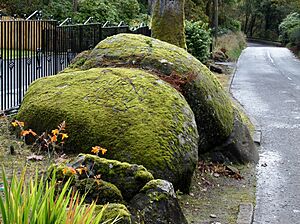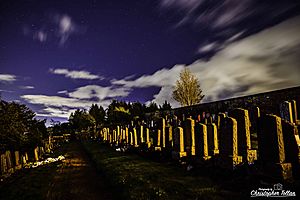Shottskirk facts for kids
Shottskirk, also known as Kirk O'Shotts Parish Church, or "The M8 Church", is a local church in Salsburgh, North Lanarkshire, Scotland. It serves the villages of Salsburgh and Shotts, and other small areas nearby. The last full-time minister for this church was Rev. Sheila Spence, who retired in 2000.
Contents
About the Church's History
The church is still used today and is a historic building. You can see it from the nearby M8 motorway, and it's often lit up at night. The graveyard has old gravestones from as far back as 1624. Nearby, the Fortissat area has parts of the Fortissat Stone, which was a meeting place for a group called the Covenanters. Shotts and nearby Harthill also have several monuments to the Covenanters.
Kirk O' Shotts is often called "The M8 Church" because it sits on a hill next to the busy M8 motorway. This road connects Glasgow and Edinburgh. A long time ago, this church was a Catholic place of worship called Saint Catherine's Chapel.
About 550 years ago, the areas of Bothwell and Shotts were one big parish. It stretched from the Clyde river to Linlithgowshire. In this large area, there were four places to worship. One of them was in the middle of Bothwellmuir, in a quiet place called “Bertram-Shotts.”
There was a legend about a giant named Bertram de Shotts. People said he lived in the area and scared travelers on the road between Glasgow and Edinburgh. A reward was offered to catch him. A man named William Muirhead waited for Bertram at his favorite drinking spot, a spring on a hillside. William managed to defeat the giant.
St. Catherine's Chapel was built in 1450 on Bertram's land. It was dedicated to “the blessed Virgin and Catherine of Sienna.”
Many people wondered why St. Catherine was connected to this area. In 1457, the Shotts parish became separate from Bothwell. The eastern part was given to Lord Hamilton. He rebuilt the chapel and probably rededicated it. He also started a hospital there for poor people. This was confirmed by Pope Sixtus IV on April 30, 1476. This date is St. Catherine's Feast Day, which might be why the church got its name.
Changes to the Chapel Over Time
After the Reformation in 1560, Kirk o’Shotts became a Protestant church. The old St. Catherine's church likely changed a lot and needed many repairs over the years. We don't have many records of this before 1640. In that year, church leaders met at Shotts and ordered the church to be fixed and partly rebuilt. It took more than eight years for this work to be finished.
The spot where the old church stood is now marked by a headstone. It belongs to Samuel Meuros, who worked for the church and was a school teacher from 1794 to 1837. He also led the singing. He wanted to be buried where his old desk had been. On the back of his stone, it says:
“Here stood the Precentor’s desk in the Kirk of Bertram Shotts which was rebuilt and extended in 1642.”
This stone and the burial ground of the Inglis family, which was inside the old church, help us understand where the old building was. The old church was a long, narrow building, about 70 feet long and 25 feet wide. It could only seat about 409 people. By 1817, the old church was not safe. So, people decided to build a much larger church that could hold about 1,200 worshippers.
The New Church Building
The church building you see today opened on October 26, 1821. It cost about £2,270 to build. Its tall spire was hit by lightning and completely destroyed on July 23, 1876.
One special item that connects the new church to the old one is the old sandstone baptismal font. This is a bowl used for baptisms. It was lost for many years but was later found in a pigsty, where it was being used as a feeding trough! After being cleaned and blessed again, it is still used for baptisms today.
From 1841, the number of people living in the parish grew quickly. Because of this, more churches were needed. Several new churches opened:
- Calderhead Church (1860)
- Harthill and Benhar (1877)
- Cleland Church (1878)
- Caldercruix (1893)
The Shotts Revival
On Monday, June 21, 1630, a famous event called the Shotts Revival happened. It was planned for John Livingstone, a young preacher, to speak in the churchyard that morning. This was after a special Communion weekend. He preached about a Bible verse from Ezekiel 36:25-26:
"Then will I sprinkle clean water upon you, and ye shall be clean: from all your filthiness, and from all your idols, will I cleanse you. A new heart also will I give you, and a new spirit will I put within you: and I will take away the stony heart out of your flesh, and I will give you an heart of flesh."
His sermon lasted for two and a half hours. Many people felt deeply moved by his words. About five hundred people felt a change in their hearts that morning. John Livingstone preached for many years after that. But he said he never again saw so many people touched in such a powerful way as he did that day in Shotts churchyard. According to Robert Fleming, many people were so affected by the sermon that they fell over. These people later became strong and helpful Christians.
The Covenanters
From 1638, when the National Covenant was signed, until 1688, there was a big struggle in Scotland. People argued about whether the church should be run by Presbyterianism (where ministers and elders lead) or Episcopacy (where bishops lead). This struggle became very difficult during the "killing times" from 1684-1685.
Shotts and the nearby areas of Monkland and Cambusnethan strongly supported the Covenant. Many secret outdoor church meetings, called "conventicles," were held there. A main place for these outdoor sermons in Shotts was on a large mossy area between Benhar and Starryshaw. Here, at a place once known as the "Deer Slunk," Donald Cargill preached on July 26, 1681. This was the Sunday after Richard Cameron had died. John Kidd also preached here to a large group of armed Covenanters. Nearby is a large stone known as ‘Peden’s Stane,’ named after the martyred Alexander Peden.
In the churchyard, there is a Covenanter's stone for William Smith. He fought at the Battle of Rullion Green in 1666. In 1678, the Duke of Monmouth led an army of 10,000 men. They camped for ten days at Muirhead, about three miles east of Kirk o’Shotts. They were on their way to Bothwell Bridge, where they defeated the Covenanters. It is thought that 160 men from Shotts took part in that battle. Thirteen of them were killed, and 33 were taken prisoner.
The Patronage Act
The Patronage Act 1711 caused a lot of problems in the parish. This law changed who could choose ministers. Instead of the church members choosing, a wealthy landowner or "patron" got to choose. This led to at least two times when ministers were forced upon the church. The most well-known was Rev. Lawrence Wells. His appointment was so unpopular that many people left the church. They joined a group called the "seceders" and eventually built their own church at Shottsburn. It wasn't until 1975 that this group rejoined Kirk o’ Shotts.
The Last Full-Time Minister
In 1979, Reverend Sheila Spence became the minister of this church. She was one of six women who wrote an open letter to the Church of Scotland. They asked for women to be allowed to become ministers. This right was granted the following year, in 1968. Rev. Spence retired in 2000, but she continued to work as a temporary minister until 2004. The house where she lived was sold. This was because the church decided that the next minister would be shared with another church.
Haunted Graveyard Legend
Some people say the church graveyard is haunted. A driver reported hitting a mysterious person dressed in grey on the road next to the church (the B7066). However, when the driver got out to check, the person had disappeared into the mist they seemed to come from.
St. Catherine's Well or "Kate's Well"
St. Catherine's Well, also known as Kate's Well, is a historic natural spring. It is very interesting and sits on holy ground at the foot of Kirk O' Shotts Parish Church. The well dates back to the 1300s. It gets its name from the church's past, when it was a Catholic place of worship called St. Catherine's Chapel. This chapel was named after Catherine of Sienna.





